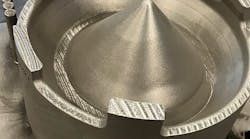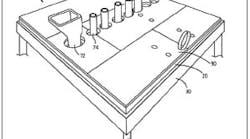By Paul DQ Campbell
True story: In 1976, during the American bicentennial, a group of mock protestors from the Procrastinators Society of America picketed the Whitechapel Bell Foundry in London, where the original Liberty Bell was cast in 1753. The picketers carried placards declaring “We Got a Lemon!” and What About the Warranty? Whitechapel very kindly responded they would be happy to replace the bell … as long as it was returned to them in its original packaging.
Try as we may, castings will crack. More annoying still is that the mold sometimes cracks long before the metal ever finds its way out of the crucible. The simple act of handling the cope and drag can be enough to ruin the cope. On March 8, Waukesha Foundry Inc., Waukesha, WI, patented a way to overcome this problem with a new process they have aptly named In-Place Cope Molding. “IPCM allows the cope half of the mold to be produced directly on top of the drag half of the mold by use of a separation barrier which supports the sand above the mold cavity in the drag. This method reduces or eliminates parting line flash, and also avoids the need to turn over or otherwise handle the cope, allowing the cope to be made thinner than a traditional cope and allowing for lower material costs.”
That last detail presents a salient aspect of this new technology: reducing costs. The patent makes something of a point that sand and binders are the significant costs involved in the production of a mold, “particularly if expensive additives are used.” Therefore, the concept of IPCM reduces the amount of material required to make the cope section of the mold, and reduces the costs associated with having to remake a cope that is fractured in the process of getting it into position. Other factors also contribute to cost reductions. Because the cope does not have to be strong enough to be rolled or flipped over it can be made with less binder content, and with binders that are not as high in strength. The combined reduction in the volume of molding sand mixture used, the reduction in the volume of the binder in the remaining mixture, and use of lowerstrength binders combine for a substantial reduction in moldmaking costs.
The process entails placing a barrier over the drag and then forming the cope on top of that barrier. As is the custom with patented technologies, the material of the barrier is left at the discretion of the user, depending on the nature of the mold in question. However, it suggests anything from paper to a board may be used, but plastic film and mica paper are also suggested in the patent. In practice the drag is placed in position, and the barrier is glued to the open cavity. Once the barrier is set, the cope is formed in place on top of it. The final choice of barrier material is dependent on the distance that needs to be spanned. Small span cavities may use paper, whereas mica paper is used for larger spans.
Now, here’s the rub. While the patent makes some issue of the placement of standard features such as sprues, vents, and flow-offs, it does not mention internal features on the cope. This seems reasonable, as it would be essentially impossible to form an internal feature without a sacrificial core, such as a Styrofoam fixture. So the process is limited in its application to molds with flat copes. However, the advantage is that the cope can be only one inch thick, or even less!
Waukesha Foundry addressed a potential pitfall of the cope floating under the pressure of molten metal delivered to the mold. The vastly reduced thickness, and therefore weight, of the cope makes this a potential problem. It’s not exactly rocket science, but to avoid “cope float” a backing plate is placed over the cope and then weighted or clamped down onto the drag.
Interestingly, the patent goes to the extent of explaining that the use of a barrier and IPCM doesn’t require a thinner cope. The final provision of the patent calls for the formation of an initial thin cope, and once the binders in the thin cope are set the remaining sand/binder mixture is added over the top to create a cope of traditional thickness. This, essentially, is done in place of using a backing plate and clamps or weights. Not as cost-effective perhaps, but a good option if the circumstances merit it.
Paul DQ Campbell is an author and freelance technology writer. For more information or to contact Paul, visit www.pdqcampbell.com










